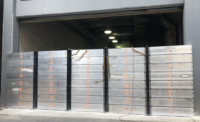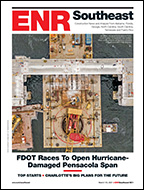...down the road,” says Tim Connell, Corps project manager. The extra 2 ft was included to accommodate unknown variables, he says. The design change means the facility will lose that extra margin. Reducing the discharge elevation by 2 ft allows the Corp to keep the same engine and pumps, but those pumps will operate more efficiently, Connell says. Fewer pump bays means fewer foundation piles, fuel tanks, maintenance costs, etc., Podany adds.
HNTB Corp. recommended “modifying the pumping units to give them greater discharge capacity in order to reduce the number of pumps required,” says Bob Ivarson, practice director, water resources, for HNTB, technical lead on the pump-station design. “Our role in the project was the design of the pumping units [diesel-engine drives and auxiliaries, speed reducers and pumps], auxiliary equipment [overhead crane, emergency-power generation, fuel storage and trash racks and rakes] and superstructure and safe house/control room,” Ivarson says. HNTB also recommended changing the trash-raking equipment, but those design changes are not being implemented by the Corps, Ivarson says.
The final analysis of pump modeling is being performed by Fairbanks Morse Engine, Beloit, Wis., and verified by the Corps’ Engineering Research and Design Center in Vicksburg, Miss., Connell says.
Cutting the number of pumps, along with the decision to trade off an interior crane for a mobile A-frame for maintenance, allowed the Corps to reduce the height of the building by 40% and the width by 33%, Connell says. “We have changed to a building that covers just the engines,” he says. The building height will be cut from 80 ft to about 50 ft and the length from 642 ft to 560 ft.
The 20,000-cfs station is the central component of the complex, which also includes up to 4,200 linear ft of T-walls, two gates and earthen levee. Its strategic placement as a barrier at the conflux of the Harvey and Algiers canals will shield an existing 25 miles of levees and floodwalls from direct storm-surge impact.
Under the Corps’ initial plan, the complex was to include two navigational sector gates, one 225 ft wide and another 75 ft wide. Based on design summit recommendations, the Corps decided to replace the 75-ft-wide sector gate with less costly sluice gates. “The 75-ft gate had three purposes: to facilitate maintenance with a secondary passageway, facilitate navigation as we get closer to a storm period, and pass the 10-year rain event without having any impacts to navigation,” Connell says. “The sluice gates will serve those same purposes.”
Another design change involved changing the gate structure’s design load from one based on installing in the dry to the actual, water-condition, maintenance loads, Podany says. It means dry gates will need additional temporary support during construction and maintenance, but the change lets designers cut the 900,000 lb estimated weight of the gates by about 200,000 lb.
Another “huge outcome” of the design summit is the gates now will be constructed within one cofferdam, instead of two, Podany says. “By going to these changes and not having to construct a separate cofferdam, we have reduced the construction schedule by a year,” he says.
As a result of the design summit, the Corps estimates saving $50 million to $100 million on changes to the large sector gate, as well as $5 million to $25 million each on changes to the small gate, site work and concrete floodwall construction. “These are rough-order magnitude numbers and do not include indirect costs such as time and labor,” Podany says.



